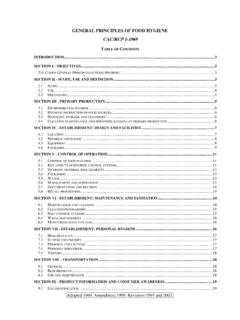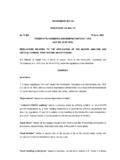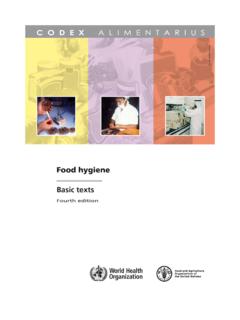Transcription of Hazard Analysis and Critical Control Point (HACCP) System ...
1 12 1 The Principles of haccp set the basis for the requirements for the application of haccp , while the Guidelinesprovide general guidance for practical Analysis and Critical Control Point ( haccp ) System and Guidelines for its ApplicationPreambleThe first section of this document sets out the principles of the Hazard Analysis and CriticalControl Point ( haccp ) System adopted by the CAC. The second section provides general guidance forthe application of the System while recognizing that the details of application may vary depending on thecircumstances of the food haccp System , which is science based and systematic, identifies specific hazards andmeasures for their Control to ensure the safety of food.
2 haccp is a tool to assess hazards and establishcontrol systems that focus on prevention rather than relying mainly on end-product testing. Any haccp System is capable of accommodating change, such as advances in equipment design, processingprocedures or technological can be applied throughout the food chain from the primary producer to final consumerand its implementation should be guided by scientific evidence of risks to human health. As well asenhancing food safety, implementation of haccp can provide other significant benefits. In addition, theapplication of haccp systems can aid inspection by regulatory authorities and promote internationaltrade by increasing confidence in food successful application of haccp requires the full commitment and involvement ofmanagement and the workforce. It also requires a multidisciplinary approach; this multidisciplinedapproach should include, when appropriate, expertise in agronomy, veterinary health, production,microbiology, medicine, public health, food technology, environmental health, chemistry, and engineeringaccording to the particular study.
3 The application of haccp is compatible with the implementation ofquality management systems, such as the ISO 9000 series, and is the System of choice in the managementof food safety within such the application of haccp to food safety was considered here, the concept can be appliedto other aspects of food (verb):To take all necessary actions to ensure and maintain compliance with criteria establishedin the haccp (noun): The state wherein correct procedures are being followed and criteria are Measure: Any action and activity that can be used to prevent or eliminate a food safetyhazard or reduce it to an acceptable Action: Any action to be taken when the results of monitoring at the CCP indicate a lossof ControlPoint (CCP):A step at which Control can be applied and is essential to prevent or eliminate afood safety Hazard or reduce it to an acceptable Limit: A criterion which separates acceptability from : Failure to meet a Critical diagram: A systematic representation of the sequence of steps or operations used in theproduction or manufacture of a particular food :A System which identifies, evaluates, and controls hazards which are significantfor food Plan:A document prepared in accordance with the principles of haccp to ensurecontrol of hazards which are significant for food safety in the segment of thefood chain under :A biological, chemical or physical agent in, or condition of, food with thepotential to cause an adverse health Analysis .
4 The process of collecting and evaluating information on hazards and conditionsleading to their presence to decide which are significant for food safety andtherefore should be addressed in the haccp :The act of conducting a planned sequence of observations or measurements ofcontrol parameters to assess whether a CCP is under :A Point , procedure, operation or stage in the food chain including raw materials,from primary production to final :Obtaining evidence that the elements of the haccp plan are :The application of methods, procedures, tests and other evaluations, in additionto monitoring to determine compliance with the haccp haccp System consists of the following seven principles:Principle 1 Conduct a Hazard 2 Determine the Critical Control points (CCPs).Principle 3 Establish Critical limit(s).Principle 4 Establish a System to monitor Control of the 5 Establish the corrective action to be taken when monitoring indicates that a particular CCP is not 6 Establish procedures for verification to confirm that the haccp System is working 7 Establish documentation concerning all procedures and records appropriate to these principles and for the Application of the haccp System Prior to application of haccp to any sector of the food chain, that sector should be operatingaccording to the Codex General Principles of Food Hygiene, the appropriate Codex Codes of Practice,and appropriate food safety legislation.
5 Management commitment is necessary for implementation of aneffective haccp System . During Hazard identification, evaluation, and subsequent operations indesigning and applying haccp systems, consideration must be given to the impact of raw materials,ingredients, food manufacturing practices, role of manufacturing processes to Control hazards, likely end-use of the product, categories of consumers of concern, and epidemiological evidence relative to intent of the haccp System is to focus Control at CCPs. Redesign of the operation shouldbe considered if a Hazard which must be controlled is identified but no CCPs are should be applied to each specific operation separately. CCPs identified in any given example inany Codex Code of Hygienic Practice might not be the only ones identified for a specific application ormight be of a different nature. The haccp application should be reviewed and necessary changes made when any modificationis made in the product, process, or any is important when applying haccp to be flexible where appropriate, given the context of theapplication taking into account the nature and the size of the application of haccp principles consists of the following tasks as identified in the Logic Sequencefor Application of haccp (Diagram 1).
6 haccp teamThe food operation should assure that the appropriate product specific knowledge and expertiseis available for the development of an effective haccp plan. Optimally, this may be accomplished byassembling a multidisciplinary team. Where such expertise is not available on site, expert advice shouldbe obtained from other sources. The scope of the haccp plan should be identified. The scope shoulddescribe which segment of the food chain is involved and the general classes of hazards to be addressed( does it cover all classes of hazards or only selected classes). productA full description of the product should be drawn up, including relevant safety information suchas: composition, physical/chemical structure (including A, pH, etc.), microcidal/static treatments ( , freezing, brining, smoking, etc.), packaging, durability and storage conditions and methodof intended useThe intended use should be based on the expected uses of the product by the end user orconsumer.
7 In specific cases, vulnerable groups of the population, institutional feeding, may have tobe flow diagramThe flow diagram should be constructed by the haccp team. The flow diagram should coverall steps in the operation. When applying haccp to a given operation, consideration should be given tosteps preceding and following the specified confirmation of flow diagramThe haccp team should confirm the processing operation against the flow diagram during allstages and hours of operation and amend the flow diagram where all potential hazards associated with each step, conduct a Hazard Analysis , andconsider any measures to Control identified hazards (see Principle 1)The haccp team should list all of the hazards that may be reasonably expected to occur at eachstep from primary production, processing, manufacture, and distribution until the Point of haccp team should next conduct a Hazard Analysis to identify for the haccp plan whichhazards are of such a nature that their elimination or reduction to acceptable levels is essential to theproduction of a safe 2 Since the publication of the decision tree by Codex, its use has been implemented many times for training many instances, while this tree has been useful to explain the logic and depth of understanding needed to determineCCPs, it is not specific to all food operations, slaughter.
8 And therefore it should be used in conjunction withprofessional judgement, and modified in some conducting the Hazard Analysis , wherever possible the following should be included:Cthe likely occurrence of hazards and severity of their adverse health effects;Cthe qualitative and/or quantitative evaluation of the presence of hazards;Csurvival or multiplication of microorganisms of concern;Cproduction or persistence in foods of toxins, chemicals or physical agents; and,Cconditions leading to the team must then consider what Control measures, if any, exist which can be applied for each Hazard . More than one Control measure may be required to Control a specific Hazard (s) and more than onehazard may be controlled by a specified Control Critical Control points (see Principle 2)2 There may be more than one CCP at which Control is applied to address the same Hazard . Thedetermination of a CCP in the haccp System can be facilitated by the application of a decision tree, 2, which indicates a logic reasoning approach.
9 Application of a decision tree should be flexible,given whether the operation is for production, slaughter, processing, storage, distribution or other. Itshould be used for guidance when determining CCPs. This example of a decision tree may not beapplicable to all situations. Other approaches may be used. Training in the application of the decisiontree is a Hazard has been identified at a step where Control is necessary for safety, and no controlmeasure exists at that step, or any other, then the product or process should be modified at that step, or atany earlier or later stage, to include a Control measure. Critical Limits for each CCP (see Principle 3) Critical limits must be specified and validated if possible for each Critical Control Point . In somecases more than one Critical limit will be elaborated at a particular step. Criteria often used includemeasurements of temperature, time, moisture level, pH, A, available chlorine, and sensory parameterswsuch as visual appearance and a Monitoring System for Each CCP (see Principle 4)Monitoring is the scheduled measurement or observation of a CCP relative to its Critical limits.
10 The monitoring procedures must be able to detect loss of Control at the CCP. Further, monitoring shouldideally provide this information in time to make adjustments to ensure Control of the process to preventviolating the Critical limits. Where possible, process adjustments should be made when monitoring17results indicate a trend towards loss of Control at a CCP. The adjustments should be taken before adeviation occurs. Data derived from monitoring must be evaluated by a designated person withknowledge and authority to carry out corrective actions when indicated. If monitoring is not continuous,then the amount or frequency of monitoring must be sufficient to guarantee the CCP is in Control . Mostmonitoring procedures for CCPs will need to be done rapidly because they relate to on-line processes andthere will not be time for lengthy analytical testing. Physical and chemical measurements are oftenpreferred to microbiological testing because they may be done rapidly and can often indicate themicrobiological Control of the product.















